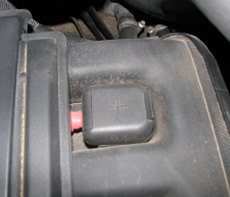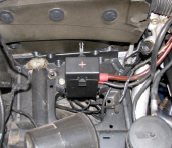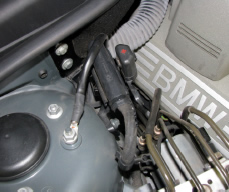If you find yourself in the uncomfortable situation of needing a jump start, below is a set of "how-to" instructions. Even though your car is a BMW or MINI, it can be jumped if needed by someone who knows what they are doing. It does take a little safety practice and awareness to make sure things are done right, though, and that's what we are going to talk about!
 CAR BATTERY INFORMATION This is a basic BMW battery. On most BMW's they are located in the trunk on the right side. The same is true for most MINI Coopers, though a few MINI's are located in the front under the hood.
CAR BATTERY INFORMATION This is a basic BMW battery. On most BMW's they are located in the trunk on the right side. The same is true for most MINI Coopers, though a few MINI's are located in the front under the hood.
This next part may seem overly simple to some readers, but I've seen enough toasted remains of ECU's and just want to make sure we're all on the same page. Red (+) is the positive side of the battery. It normally (but not always) has a red wire connected to it.
The (-) sign means the ground or negative side of the battery. It will generally be connected to a black or sometimes brown wire.
WARNING: If you attempt to jump start and accidently mix up the leads...it's very dangerous to you and the car, so be careful!
 JUMP START FUNDAMENTALS Your car will typically have a "jump" point under the hood. The location and look of the jump point varies from model to model but will share similar characteristics.
JUMP START FUNDAMENTALS Your car will typically have a "jump" point under the hood. The location and look of the jump point varies from model to model but will share similar characteristics.
 Traditionally, the Positive (+) jump point will be under a small flip-lid with a Red (+) on it. The Negative (-) point is normally a large shiny nut on the strut tower or other body ground location. Jump starting from under the hood is normally the better option versus trying to jump start from the trunk.
Traditionally, the Positive (+) jump point will be under a small flip-lid with a Red (+) on it. The Negative (-) point is normally a large shiny nut on the strut tower or other body ground location. Jump starting from under the hood is normally the better option versus trying to jump start from the trunk.
 SEQUENCE Now that you have found the (+) and the (-) jump points, it is time to talk sequence. Turn the good vehicle off and make sure all headlights, blinkers, car radios and A/C's are off, radar detectors are unplugged, cell phones unplugged, everything off.
SEQUENCE Now that you have found the (+) and the (-) jump points, it is time to talk sequence. Turn the good vehicle off and make sure all headlights, blinkers, car radios and A/C's are off, radar detectors are unplugged, cell phones unplugged, everything off.
STEP 1: Connect one end of the Positive (+) cable to the Positive (+) post of the dead battery.
STEP 2: Connect the other end of the Positive (+) cable to the Positive (+) jump point.
STEP 3: Connect one end of the Negative (-) cable to the Negative (-) post of the good battery.
STEP 4: Connect the other end of the Negative (-) cable to the Negative (-) jump point of the dead car. You usually want to avoid placing the Negative (-) cable directly on the dead battery to minimize the chance for explosions. You should only use the ground post on the dead battery as a last resort. On this step you'll get a normal spark as you connect the ground and complete the circuit.
Start the good car's engine, and make sure the headlights are off, to allow the maximum amount of power to get to the dead battery. Let the good car's engine run a minute or so before attempting to start the dead car. Sometimes you get lucky and the dead battery will jump start right away, sometimes it takes a few minutes. If your dead car's interior dome light comes on, it's a great sign that you've connected the cables right. Now shut all doors and dome lights and try to start the car. If it sounds like it's trying to crank but won't turn over completely, give it a few more minutes and rev the engine moderately on the good car. After a few minutes, you should be able to start your car!
Now that your dead car has been successfully jump started, you can remove the cables in the reverse order that you connected them being careful not to let the battery cable clamps from touching each other:
STEP 1: Disconnect the Negative (-) cable from the engine block of the car that was jump started.
STEP 2: Disconnect the other end of the Negative (-) cable from the Negative (-) post of the good battery.
STEP 3: Disconnect the Positive (+) cable from the Positive (+) post of the good battery.
STEP 4: Disconnect the other end of the Positive (+) cable from the Positive (+) post of the dead battery.
After your revived car has been running a few minutes, turn off the engine and see if it will restart on its own, no cables attached.
 Mon-Fri: 7am-5pm
Mon-Fri: 7am-5pm (479) 717-2888
(479) 717-2888 126 S Goad Springs St, Lowell, AR 72745
126 S Goad Springs St, Lowell, AR 72745
 Sign-up today for service interval reminders such as: oil & filter, brakes, tires, and more... These parts are designed to wear & need to be replaced before any major damage occurs. We can help.
Sign-up today for service interval reminders such as: oil & filter, brakes, tires, and more... These parts are designed to wear & need to be replaced before any major damage occurs. We can help.